Soothe little souls with these top pacifiers for newborns, infants, and toddlers.
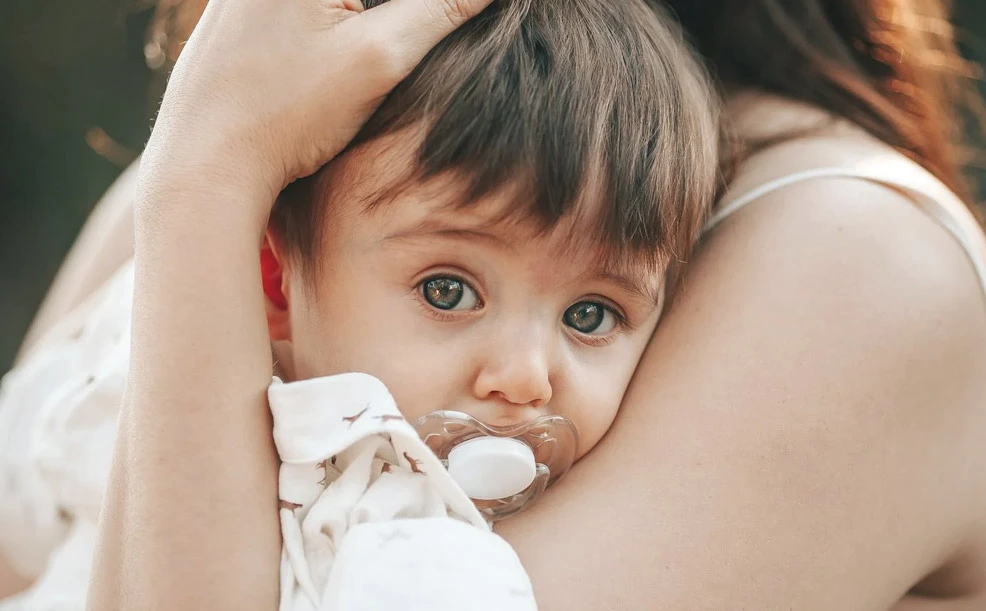
Mommyhood101 independently tests and curates baby gear to help you make informed decisions. If you buy products through links on our site, we may earn a commission.
Sucking on a pacifier can help calm and soothe a fussy baby, help them fall asleep and stay asleep, and even reduce the risk of sudden infant death syndrome (SIDS).
While pacifiers are controversial to some, the research shows that using a pacifier during the first 6 months of life only has benefits for your baby's health and safety.
We've been reviewing pacifiers for over 10 years, and if we made our own, here are some of the key features it would have:
✔️ Latex & BPA free.
✔️ Trusted by pediatricians.
✔️ Meets AAP guidelines.
✔️ Orthodontic design.
✔️ One-piece design.
✔️ Hospital-grade silicone.
✔️ Dishwasher safe.
✔️ Sterilizer safe.
✔️ Attaches to plushes & clips.
✔️ Durable construction.
✔️ Easy to find in the dark!
✔️ Can be placed in freezer.
Of course, you will also want the pacifier to meet any design preferences, be readily accepted by your little one, and meet your budget constraints.
-
- Top 5 Pacifiers Comparison Table
- In-Depth Reviews
- 1. Best Overall: Philips AVENT
- 2. Medela Pacifiers
- 3. Itzy Ritzy Sweetie Soothers
- 4. WubbaNub Pacifiers
- 5. Chicco PhysioForma Two-piece
- 6. Dr. Brown's HappyPaci
- 7. Chicco Physioforma One-piece
- 8. MAM Orthodontic
- 9. NUK Orthodontic
- Are Pacifiers Bad to Use?
- Appropriate Ages for Pacifier Use
- 0-6 Months
- 6-12 Months
- 12-36 Months
Full disclosure: Some of these pacifiers, including the Chicco, MAM, Medela, and Itzy Ritzy models, were sent to us as free test samples by the manufacturer.
Here are the top 5 pacifiers we've tested, followed by in-depth reviews of several options.
The Top 5 Best Pacifiers of 2026
| ★★★★★★★★★★ (10/10) | Trusted by hospitals and parents alike, these one-piece silicone pacifiers are BPA-free, durable, and perfectly sized for newborns. Easy to sterilize, affordable, and highly accepted by infants. | CHECK PRICES | READ FULL REVIEW | |
| ★★★★★★★★★★ (10/10) | Orthodontic silicone pacifiers in multiple sizes, featuring SensoPearls for breathability and a comfy, secure fit. Includes a sterilizer case and clip attachment hole for convenience. | CHECK PRICES | READ FULL REVIEW | |
| ★★★★★★★★★★ (10/10) | Stylish and soft 100% silicone pacifiers with orthodontic and soothie options for all ages. Dishwasher safe, ASTM-certified, and baby-approved in adorable colors and shapes. | CHECK PRICES | READ FULL REVIEW | |
| ★★★★★★★★★☆ (9.5/10) | Adorable animal plushes paired with soothie-style pacifiers make this the best choice for 3-6 months. Soft, safe, and soothing—plus easier to find in the crib or car seat! | CHECK PRICES | READ FULL REVIEW | |
| ★★★★★★★★☆☆ (8/10) | Orthodontic two-piece pacifiers designed with pediatric experts to promote proper oral development and breathing. Includes glow-in-the-dark version and sterilizer case. | CHECK PRICES | READ FULL REVIEW |
Some parents avoid using pacifiers to prevent their babies from becoming too dependent on them for sleep or soothing. Some also believe that it might interfere with breastfeeding, cause dental problems, or increase the rate of ear infections.
At the bottom of this article, we go into depth on the pros and cons of pacifier use, including which pacifiers to use at what time, and how to transition away from a pacifier.
Spoiler alert: Pacifiers are beneficial for the first six months of your baby's life, but should be discontinued in most cases as they get older (i.e., over 6-12 months). These aren't opinions, all of our recommendations are based on published pediatrics research.
There are two main types of pacifiers:
Newborn pacifiers: These soother pacifiers are cylindrical in shape and designed for use during the first 8-12 weeks of life.
Orthodontic pacifiers: Once your child is over 8-12 weeks of age, they will likely transition to an orthodontic pacifier, which is shaped to contour to your baby's tongue and the roof of their mouth.
Our reviews consider both newborn soother and orthodontic pacifiers.
When picking the perfect pacifier, you might want to also consider which of the best baby bottles might use a similar (or even the same) nipple shape, to help with transitions.
In-Depth Reviews of the Best Pacifiers
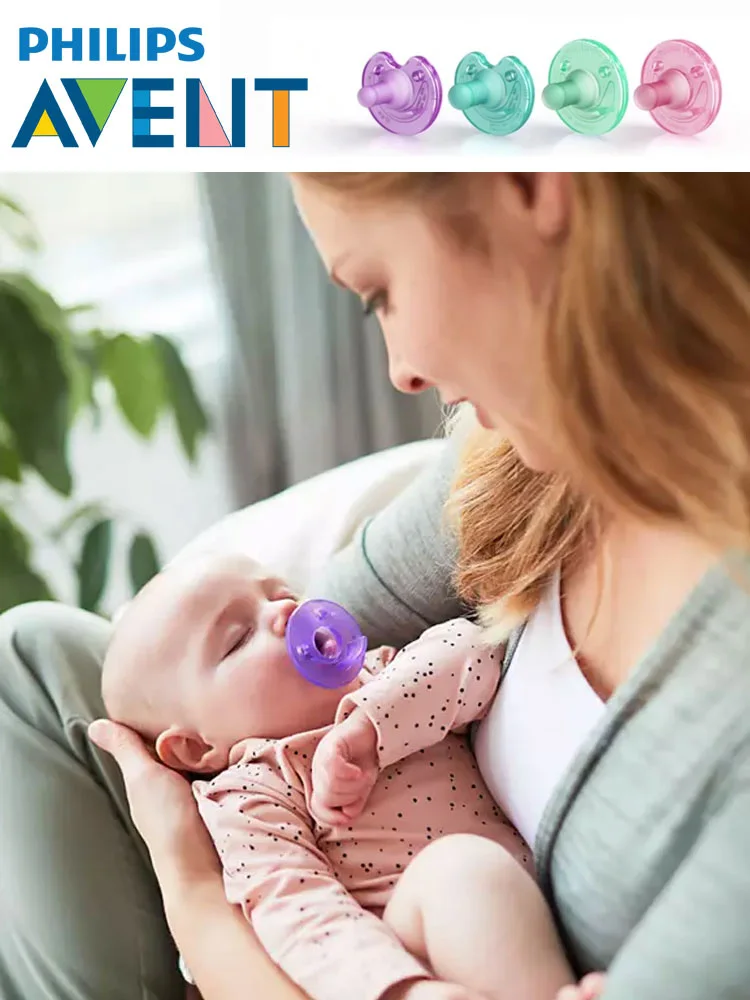
1. Philips AVENT Soothie Pacifier.
This is the best pacifier for newborns, from about 0-3 months of age. The Philips AVENT Soothie Pacifier is the #1 pacifier distributed by hospitals across the country. That's not only because Philips has struck an amazing deal with hospitals, but also because they are a widely trusted newborn pacifier for safety, effectiveness, acceptance, and low risk of nipple confusion. For safety, they are made with silicone and are BPA-free, latex-free, have air holes around their shield, are durable, and use a one-piece construction. For functionality, they have a great shape that closely resembles a nipple, giving them high rates of acceptance and low rates of nipple confusion. They use a tab design for parents to grab and pull in or out; they avoided using a ring to prevent newborns from hooking a finger on it and accidentally pulling it out of their own mouths (it happens!). For cleaning, they can be steamed, boiled, or dishwasher cleaned for sterilization, and the back of the nipple is completely hollow so water will never get trapped inside the pacifier's nipple.
The nipple is small enough to fit a newborn's little mouth, the shield isn't large enough to bump up against the nose of *most* babies, and they adhere to the pacifier guidelines of the American Academy of Pediatrics. We also need to point out that each pacifier is only about 2 bucks and they come in pink, purple, blue, green, or yellow. What's not to love!? Well, they're not the cutest pacifiers, and as your baby gets a little more tongue control they will be able to easily pop it out of their mouth. We think it's the perfect first pacifier for newborns aged 0-3 months. Who else recommends the Philips AVENT Soothie Pacifier? Our friends at Babylist, Babygearlab, and WhatToExpect also consider it a top pick! Impressed? You can check out the Philips AVENT Soothie Pacifiers here.
2. Medela Silicone Orthodontic Pacifiers.
Medela makes some of the best breast pumps on the market and is world-renowned for its expertise in everything related to infant feeding. Not only do they make great pumps, they also make baby bottles, nursing bras, nipple creams, nursing pillows, and (you guessed it) pacifiers! Medela was kind enough to send us samples of their awesome new silicone pacifiers in the newborn (<2 months), 0-6 months, and 6-18 month versions. We distributed them to a bunch of new moms and tried a few ourselves - boiling them, steaming them, and trying (unsuccessfully) to stretch them apart! The < 2-month version is super small, with a teat that is only about 1.5cm wide and 0.5cm thick and uses a two-piece design with the soft silicone teat and a relatively rigid shield with six air vents. We think it's best for the real little ones, including premature infants, given its size. The 0-6 month version will be suitable for most newborns and up to about 4-6 months old, and the 6-18 month one will likely bring you right to the pacifier finish line! The 0-6 and 6-18-month versions use a one-piece silicone design and are available in either fully transparent (clear) or shades of transparent blue or pink. All of them use the popular SensoPearls, which provide micro-indentations along the guard to keep a tiny air gap between the guard and your baby's skin; very helpful for reducing the odds of dryness, redness, and chapped cheeks under the pacifier.
The six moms who tested the pacifiers used them on two newborns, three infants (6-11 months), and one toddler (14 months). None of them had tried Medela pacifiers before, and they had been using a mixture of MAM, NUK, and Philips AVENT with their little ones. All six moms appreciated how simple and lightweight the pacifiers are, their shape and quality, and how durable and easy to clean they were. The orthodontic shape of the nipple, across all three sizes, was appreciated by two of the moms who don't have great success with the soothie-style pacifiers. All five of the infants accepted the pacifiers without any difficulty, and the moms commented that they did a good job staying in the mouth. They also appreciated the small hole on the front of the shield where you can easily attach a pacifier clip and the fact that they came with a sterilizing box. The only tester who didn't appreciate the Medela was the toddler, but he was very attached to his NUK pacifiers. The only drawback that moms mentioned was the transparent pacifier style: while it looks nice and modern, it also can make it harder to find when it falls (and it will)! We strongly suggest investing in some pacifier clips such as these clips by Medela, to save yourself some frustration. Outside of that little con, all of the parents loved the Medela pacifiers and thought they were fantastic! Interested? You can check out the Medela Pacifiers here.
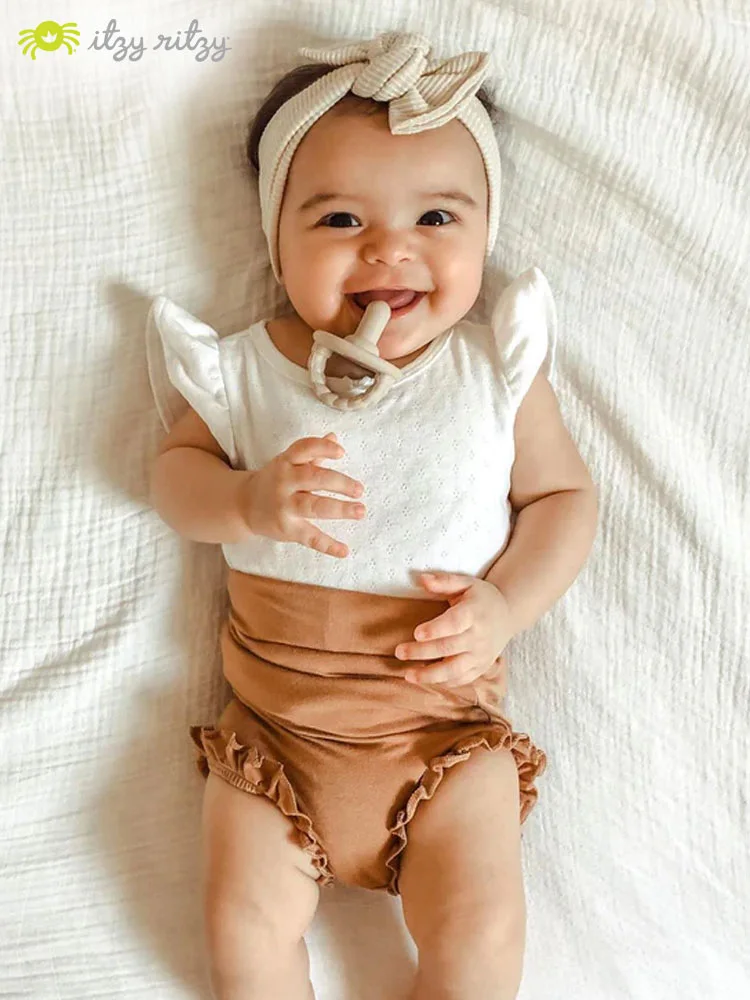
3. Itzy Ritzy Sweetie Soother Pacifiers.
We all know and love Itzy Ritzy for their amazing line of diaper bags, loveies, and teething toys, but did you know they also make some of the most adorable and effective pacifiers? The Sweetie Soothies line of pacifiers spans from newborn (non-orthodontic, 0-6 months) to toddler (orthodontic, 6-18 months), and all are made of 100% food-grade silicone, are BPA, phthalate, and PVC-free, and meet ASTM safety standards. The pacifiers have an easy-to-grasp loop, dual vent holes, and super soft nipples. The conventional soothie-style for infants is shaped very nicely, with a very subtle contour towards the tip. The orthodontic style for older little ones (6+ months) has a great shape for hitting the tongue and palate in an appropriate way, without putting undue pressure on the gums where teeth are sprouting.
In our testing, the Sweetie Soothers were taken immediately by our three test babies (4 months, 8 months, and 13 months) and did a great job soothing them during the day, naps, and at bedtime. We didn't have any issues with the pacifier popping out of mouths, at least not more than any other pacifier we've tested. The silicone was soft yet durable, and the nipple size will be great for most infants. Always boil a new pacifier before its first use, and be sure to clean them regularly. These Itzy Ritzy pacifiers are top-rack dishwasher safe, and you can also boil them, wipe them off, and wash them with soap (but avoid using antibiotic soaps or abrasive cleaners on silicone). If you love the colors and styles of the Itzy Ritzy, you're not alone, it's one of the most popular pacifiers of the year! And if you love these but also love the style of the Wubbanub, be sure to check out the Itzy Ritzy Sweetie Pal soothies that incorporate awesome pacifiers with an adorable soothie animal, like Peyton the Sloth and Lane the Llama! Interested? You can check out the Itzy Ritzy Pacifiers here.
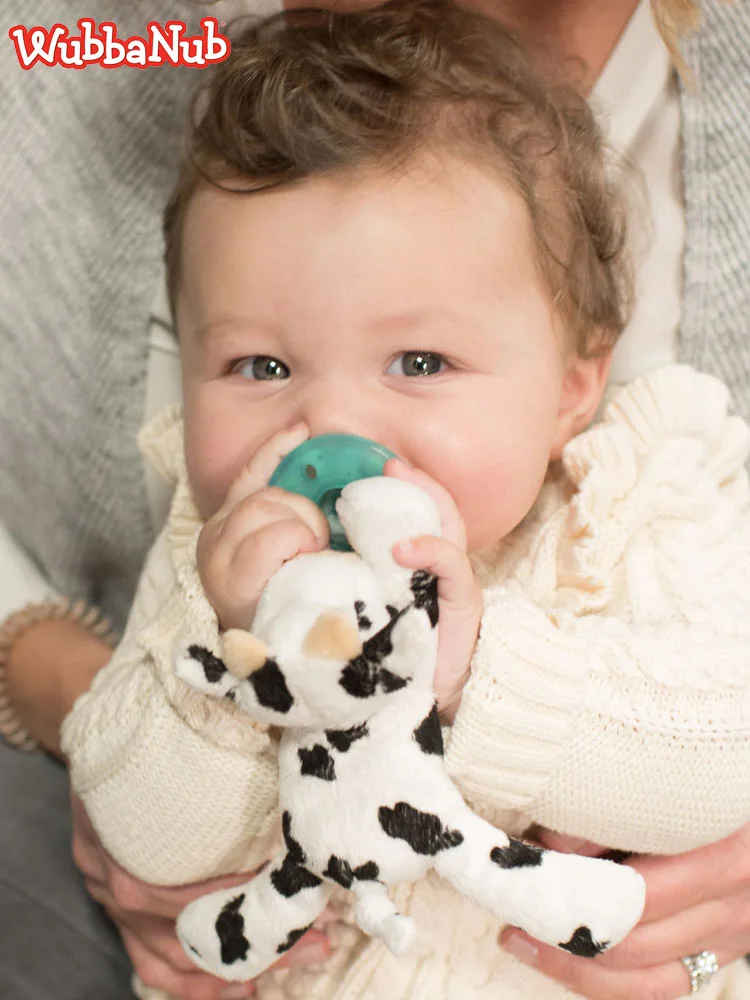
4. WubbaNub Pacifiers.
This is the best pacifier for infants from about 3-6 months of age. It doesn't get much more adorable than a WubbaNub pacifier, with its awesome soother-style nipple shape and plush animal attachments. While we showcase the adorable baby cow here, the WubbaNub is available in over 50 cute animal designs including the popular giraffe, reindeer, and lamb. We usually recommend using a newborn pacifier without a plush attached for the first 0-3 months of life and then graduating to a WubbaNub for between 3-6 months. This is for a few reasons. Newborns have little control of their hands and arms, increasing the odds that they will unintentionally grab and yank the WubbaNub pacifier right out of their mouths. By about 3 months, however, your infant will become more aware of their pacifier and gain a bit more control of their hands and arms. At this point, the WubbaNub will also start to become a familiar favorite friend, helping to soothe your baby a bit more than using just a pacifier. The WubbaNub also helps in a few additional ways: it helps keep the pacifier from falling on the floor or far away, with the animal helping the pacifier land on your child's chest, tummy, or lap. The first time your infant spits out their pacifier in a car seat or stroller, you'll see why this is such an awesome benefit!
The pacifier itself is very similar to the AVENT Soothie, with a 100% silicone construction that is free of BPA and Latex. The nipple itself is a great diameter for infants 0-6 months, and the nipple shield has two air holes for breathability. The pacifier itself is permanently attached to the plush animal, which makes cleaning and sterilizing the WubbaNub a little tricky. There are basically three options. First, you can hand-wash the entire WubbaNub and let it hang dry. Second, you can put it in a mesh laundry bag, throw it right into your washing machine, and then hang it to dry. Third, you can fill a mug with boiling water and dip just the pacifier portion into the boiling water for 2-4 minutes to sterilize it. We used the second and third options: we would machine wash the entire thing and then sterilize just the pacifier by dipping it in a mug of hot water. Easy enough! Overall, we love the WubbaNub and think it's the best pacifier for 3-6-month-old infants; with its superior convenience, style, and effectiveness, it's worth every penny! Who else loves the WubbaNub? Our friends at Babylist, Babygearlab, and WhatToExpect also consider it a top pick! Impressed? You can check out the WubbaNub Pacifiers here.
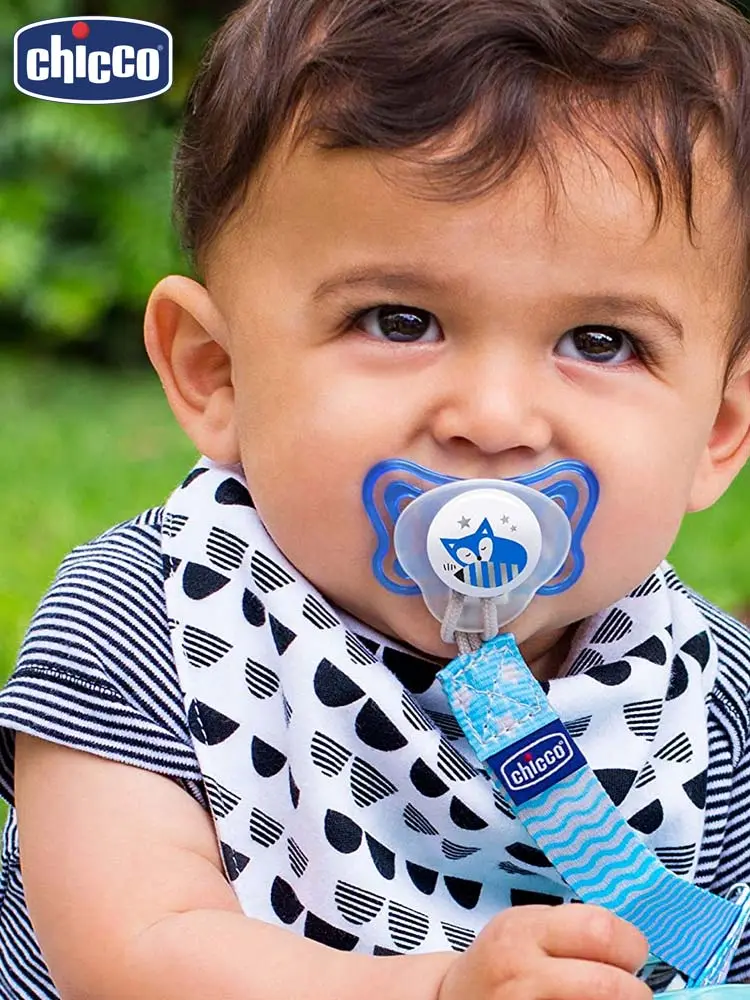
5. Chicco PhysioForma Orthodontic Pacifier (two-piece).
This is the best pacifier for infants 6 months and up. The new PhysioForma line of Chicco pacifiers was developed with a panel of pediatricians, orthodontists, and neonatologists. It combines the best in soothing and modern science to support breathing, tongue positioning, and gum and tooth development. The nipple uses a nice curve that facilitates an even distribution of pressure across the palate, along with tiny ridges to stimulate and guide tongue position. Combined with a subtle satin-like texturing, this is a truly orthodontic pacifier that conforms to the guidelines of the American Academy of Pediatrics. It's also worth noting that it's not made in China - instead, it's designed and made in Italy and is free of BPA, phthalates, and latex. These pacifiers have a great lightweight "barely there" shield for superior comfort, and lower rates of indentations and redness on the face. The Light line of Chicco pacifiers comes in three sizes - 0-6 months, 6-16 months, and 16+ months. In accordance with AAP recommendations, we suggest using this orthodontic pacifier for babies over 6 months of age. In our testing, we loved the satin feel of the nipple, its subtle tongue-stimulating texture, and its ability to conform nicely to the inside of the mouth. In contrast to one-piece silicone pacifiers, orthodontic pacifiers can be a bit harder to clean given some of the nooks and crannies. The two-pack of these pacifiers usually includes a sterilizing case and two pacifiers: one for daytime use and one glow-in-the-dark version for overnight use.
At first, we thought the glow-in-the-dark pacifier was a bit of a gimmick but then quickly realized how convenient it was when the pacifier was spat out or tossed in the middle of the night! The glowing cap made it much easier to find in the dark, and we want to thank Chicco for this little blessing! The handle knob makes it more challenging for infants to accidentally remove the pacifier from their mouth, which is good - though it's still super easy for a parent to grip. Who else loves the Chicco PhysioForma pacifiers? Our friends at Babylist and Babygearlab also consider them a top pick! Interested? You can check out the Chicco PhysioForma Pacifiers here.
6. Dr. Brown's HappyPaci.
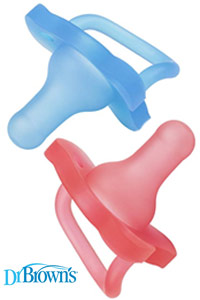
This is a fantastic pacifier for newborns from 0-3 months old, and it has some awesome features. This pacifier basically takes all that we love about the Philips and improves it with a butterfly-shaped shield that won't bump up against little baby noses, and definitely looks cuter than the big circle. It uses the same little venting holes, is BPA-free and latex-free, and is made of 100% silicone. Just like the Philips, it's easy to dish wash, steam, or boil, and has a hollow nipple that won't trap water inside. The nipple itself is exactly like the Philips nipple, so it's a great little size for newborns and is shaped much like mom's nipples. A big difference between the two options is that the HappyPaci uses a non-orthodontic nipple that's actually shaped just like the nipple used on Dr. Brown's baby bottles (one of our top-rated baby bottles!). That means if you're bottle-feeding your baby, this is a great pacifier for combining with those bottles. Another big difference is that these pacifiers use a loop gripper that is super convenient for parents and can easily clip onto a diaper bag or anywhere else. They're about $2 each just like the Philips. The only downfall of that loop is that babies can accidentally (randomly) swing their hands up and pull them out of their mouths. That's rare but will become more intentional and common as the baby gets a bit older. So this is a great alternative to the Philips AVENT, offering a non-orthodontic pacifier that is a little cuter and more functional, but that loop might cause some accidental removals. Interested? You can check out the Dr. Brown's HappyPaci Pacifiers here.
7. Chicco PhysioForma Pacifiers (one-piece).
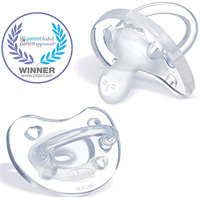
This is an awesome option for babies from about 3-6 months of age. We introduced the PhysioForma line of pacifiers above when talking about newborns, but it's worth reiterating that these pacifiers are based on physician and scientist guidance, developing pacifiers that support breathing, tongue positioning, and gum and tooth development. These infant pacifiers use a one-piece soft silicone construction with a vented shield; the nipple uses a nice curve that facilitates an even distribution of pressure across the palate, along with tiny ridges to stimulate and guide tongue position. Made in Italy, this pacifier is free of BPA, phthalates, and latex. It's available for newborn babies and older, with three different sizes (0-6 months, 6-12 months, and 16 months onward). We suggest using this pacifier for 3-6 months and then switching to one of the orthodontic options below. In our testing, all 4 of the babies loved this pacifier and didn't show any signs of rejection. It was also rare for it to accidentally pop out, and it stayed in the mouth very nicely during napping. There were a few things we loved about it. First, the one-piece design has no nooks and crannies to clean. Second, the plastic sterilizing case was convenient and easy to bring along for storage. Third, we didn't notice any pacifier indentations or marks on our test babies' cheeks, and the handle was easy to grab onto for both parents and infants who want to control their binky destiny. Downfalls? Not many! For one, it does collect a lot of fuzz and lint when moist, but that's pretty normal for a silicone pacifier. And second, because it's a slightly orthodontic nipple design, it might cause a bit of nipple confusion in some breastfed babies. Interested? You can check out the Chicco PhysioForma Newborn Pacifiers here.
8. MAM Orthodontic Pacifiers.
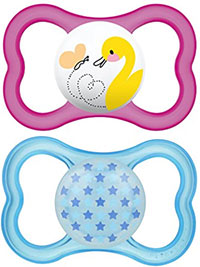
These pacifiers are great for babies about 6 months and older. The MAM orthodontic pacifiers are one of the most popular overall orthodontic pacifiers on the market and for good reason. Their new sensitive skin pacifiers are really excellent. The sensitive skin aspect keeps moisture from building up between the shield and the cheeks, to lower the risk of irritation and rash. It does this by opening up the shield entirely instead of having a few holes in it. In our testing, this design is very effective at reducing irritation in babies with sensitive skin, and all of our test babies loved these pacifiers. This wasn't especially surprising given a recent study showing a 94% acceptance rate of these pacifiers among babies. That's huge and matches our experience.
These are orthodontic pacifiers, which means that the nipple shape is designed to conform to your baby's mouth instead of pushing up against their upper and lower gums. The nipple also has an anti-slip "SkinSoft" surface to make it more comfortable in the mouth (more like skin) and make it less likely to pop out of the mouth unintentionally. The silicone is super soft, BPA-free, and is odorless, and tasteless, even before boiling it. We loved these pacifiers and found them durable and reliable after several washes and boilings, and hours of suckling! Some other things we liked were how there is no up-side or down-side, so there's no risk of putting the pacifier upside-down which is a risk with many other orthodontic pacifiers. We also liked the sterilizer case they come in: simply put some water in it and pop it in the microwave for 3 minutes - and voila, you have a sterile pacifier! Who else loves MAM pacifiers? They are also recommended by our friends at Babylist and Babygearlab! Interested? You can check out the MAM Orthodontic Pacifiers here.
9. NUK Orthodontic Pacifiers.
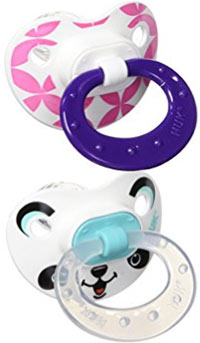
NUK and MAM make some of the best baby bottles on the market, and they are very competitive in the pacifier space as well. These NUK pacifiers have an interesting design for sensitive skin - rather than removing the majority of the shield, they left the shield but put grooves on the inside extending from the holes downward, so air can travel in and move along the cheeks. It's an innovative design that seems to help reduce irritation and rashes. There are a few differences between these and the MAM. First, the orthodontic silicone nipple is directional, meaning that there is a right-side-up for the pacifier. Second, the nipple is really awesome - it has channels on the top for up against the palate (roof of the mouth) and a contoured design that allows the tongue to move along the bottom of the nipple very nicely (they call this a "scooped" nipple cavity).
The nipple is shaped just like the popular NUK bottles, which means that there's less likelihood of confusion or rejection when switching between the pacifier and bottle. The shape of the shield is a bit heart-shaped, which helps parents realize which side is up and which is down, but also is comfy against the lips and cheeks. They are really great pacifiers, and are also pretty cheap - usually under $2 each. There are only minor downfalls relative to the MAM. First, they are directional, which means that your baby might pull it out and put it back in upside-down, defeating the purpose of the orthodontic nipple. We forgive them for that, given how great the orthodontic shape is. Second, it doesn't come with a sterilizing container like the MAM (check out our full list of the best baby bottle and pacifier sterilizers of the year!), and the shields aren't as good at preventing irritation around the mouth. We're being picky here! Interested? You can check out the NUK Orthodontic Pacifiers here.
Conclusions
Are Pacifiers Bad for a Baby?
Most of the concerns about pacifier use aren't based on facts. First, for healthy babies that are born at term (not prematurely), there is no relationship between pacifier use and breastfeeding (see the research here), so there is no evidence that it will reduce breastfeeding frequency or quality in otherwise healthy babies. Second, while some parents are concerned about the slight increase in ear infection risk, the Mayo Clinic states that lowering the risk of SIDS is much more important than a very small increase in the rate of ear infections that occurs in babies older than 6 months.
We do know, however, that prolonged use of pacifiers beyond 18-24 months, especially non-orthodontic pacifiers, can cause some misalignment of the teeth (see the research here).
Should Babies Use Pacifiers?
That's really your call as a parent. If you want the benefits of a pacifier but are worried about over-dependence or anything else, then here's what we suggest. First, you don't need to worry about the negative impacts of pacifier use from 0-6 months of age. According to the research, there are only benefits of pacifier use at this age. From 6 to 12 months, there is a slight increase in the risk of ear infections, and after 18 months there is a risk of misaligned teeth. If you choose to use a pacifier, here's our advice:
From 0-6 months: Our advice is to begin with a newborn pacifier that best resembles the shape and feel of a mom's nipple. We list those pacifiers first in our list. If you are only bottle-feeding, then we suggest using a pacifier shape that matches your baby bottles. The Dr. Brown's bottles and pacifiers are a great example of that. Getting a pacifier that closely matches the shape of your primary feeding method (nipple or bottle) will reduce any difficulty switching between a pacifier and feeding. If you're breast-pumping and bottle-feeding, this also applies to you!
From 6-12 months: This is the time frame when there is a slight increase in the risk of ear infections with pacifier use. If possible, this would be a good time to transition away from the pacifier, if that suits your baby and your lifestyle. If not, this time frame is when we suggest switching to an orthodontic pacifier.
From 12-36 months: If your toddler is still clinging to their pacifier and you're going to let them continue, we suggest trying to limit access and using only an orthodontic pacifier. With our babies, during the second year, we transitioned away from a pacifier to something else babies could chew and suck on while relaxing or falling asleep. We used the Mombella Ellie Elephant Teether, which was an amazing little tool for transitioning away from the pacifier. Be sure to also check out our reviews of the best teething toys, and best baby toothbrushes and toothpastes!






